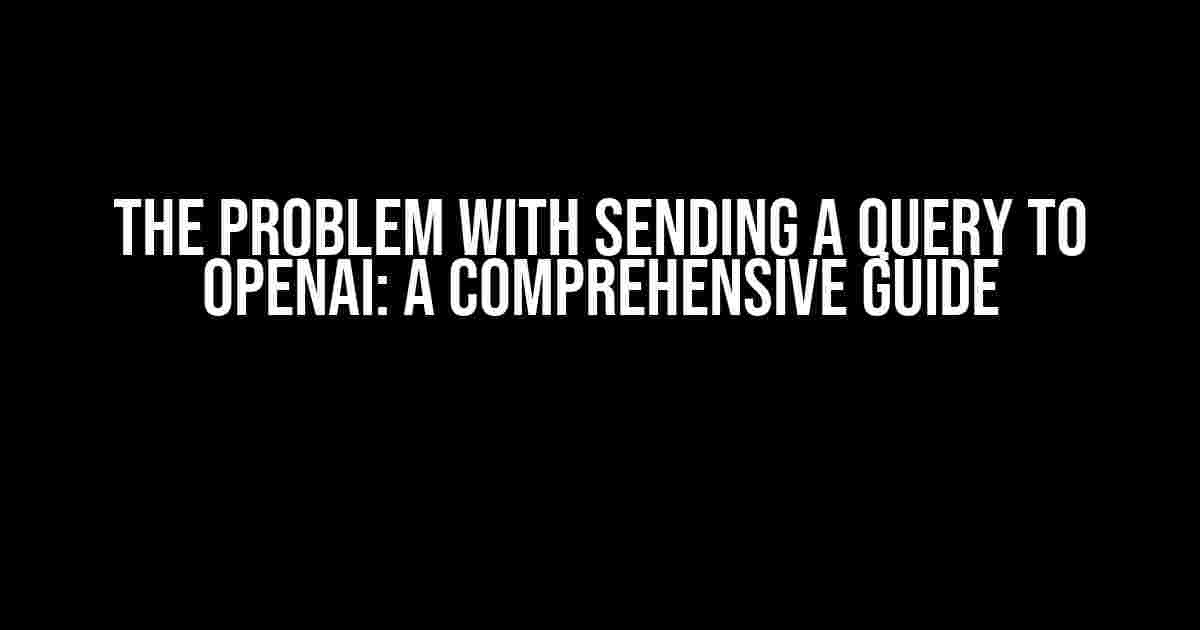Introduction
OpenAI, a renowned artificial intelligence research organization, has revolutionized the field of natural language processing (NLP) with its innovative models and APIs. One of the most popular ways to interact with OpenAI is by sending a query, which can be a simple text-based input asking for information, generation, or creation. However, many users struggle with crafting effective queries, leading to confusing or unsatisfactory responses. In this article, we’ll delve into the common problems associated with sending a query to OpenAI and provide practical solutions to overcome them.
Understanding OpenAI’s Language Model
Before diving into the problems, it’s essential to comprehend the basics of OpenAI’s language model. The model is trained on an enormous dataset of text, allowing it to recognize patterns, relationships, and context. This enables it to generate human-like responses to user input. However, this complexity can also lead to misunderstandings and miscommunication.
The Problem of Ambiguity
Ambiguity arises when the query is open to multiple interpretations, making it challenging for the model to provide a relevant response.
Problematic query:“What is the best way to travel?”Better query:“What are the best transportation options for a solo traveler in Europe?”
By specifying the context and constraints, you can help the model understand your requirements more accurately.
The Problem of Lack of Context
Failing to provide sufficient context or background information can lead to responses that don’t align with your expectations.
Problematic query:“How does AI work?”Better query:“Can you explain the basics of deep learning in natural language processing?”
Adding context helps the model to focus on the specific aspect of the topic you’re interested in.
The Problem of Vagueness
Vague queries often result in unhelpful or generic responses.
Problematic query:"Tell me something about cars."Better query:"What are the key features and benefits of electric vehicles compared to traditional gasoline-powered cars?"
Be specific about what you want to know, and the model will provide more detailed and relevant information.
Best Practices for Crafting Effective Queries
To get the most out of OpenAI’s language model, follow these best practices:
| Best Practice | Example Query |
|---|---|
| Be specific and concise | “What are the top 3 benefits of using a GraphQL API in a web application?” |
| Use relevant keywords and phrases | “How does the transformer architecture improve language translation tasks?” |
| Define the scope and context | “What are the best practices for implementing scalable machine learning models in production environments?” |
| Avoid ambiguous terms and jargon | “Can you explain the concept of overfitting in machine learning and provide an example?” |
Common Pitfalls to Avoid
In addition to the problems mentioned earlier, there are some common pitfalls to avoid when sending a query to OpenAI:
- Asking multiple questions at once
- Using overly complex language or jargon
- Failing to specify the format of the desired response (e.g., text, code, or list)
- Ignoring the character limit and sending excessively long queries
By being aware of these potential pitfalls, you can draft queries that are more likely to elicit accurate and helpful responses.
Conclusion
The problem with sending a query to OpenAI often stems from a lack of understanding of the language model’s capabilities and limitations. By recognizing the potential issues, adopting best practices, and avoiding common pitfalls, you can craft effective queries that yield valuable insights and information. Remember to be specific, concise, and clear in your queries, and OpenAI’s language model will become a powerful tool in your hands.
Additional Tips and Resources
For further guidance and exploration:
- Consult the OpenAI API documentation for detailed information on query formats and limitations.
- Explore the OpenAI community forums for examples, discussions, and feedback on crafting effective queries.
- Practice and experiment with different query types and formats to develop your skills.
By mastering the art of querying OpenAI, you’ll unlock the full potential of this powerful AI tool and unlock new possibilities for creativity, innovation, and knowledge discovery.
Frequently Asked Question
Before sending a query to OpenAI, you might have some doubts lingering in your mind. Here are some answers to put your concerns at ease.
What if my query is too vague or open-ended?
Don’t worry! OpenAI’s AI models are designed to handle vague or open-ended queries. However, it’s essential to provide some context or clarify your question as much as possible to get the most accurate and relevant response.
Will I get a human response or an automated one?
OpenAI uses a combination of human and AI-generated responses. While AI models can handle a wide range of queries, certain complex or nuanced questions may be escalated to human reviewers for a more accurate response. Rest assured, you’ll get the best possible answer!
How long does it take to get a response from OpenAI?
Response times may vary depending on the complexity of your query and the volume of requests. However, OpenAI’s AI models are designed to respond quickly, often in a matter of seconds. For more complex queries, you might need to wait a bit longer, but rest assured, you’ll get a response as soon as possible!
Can I ask follow-up questions or clarify my query?
Absolutely! You can ask follow-up questions or clarify your query to get a more precise response. OpenAI’s AI models are designed to engage in conversations and provide contextual responses. So, feel free to ask away!
Is there a limit to the number of queries I can send to OpenAI?
Currently, there is no limit to the number of queries you can send to OpenAI. However, please be respectful of the platform and avoid sending excessive or repetitive queries. OpenAI aims to provide a valuable resource for users, and your cooperation is appreciated!

